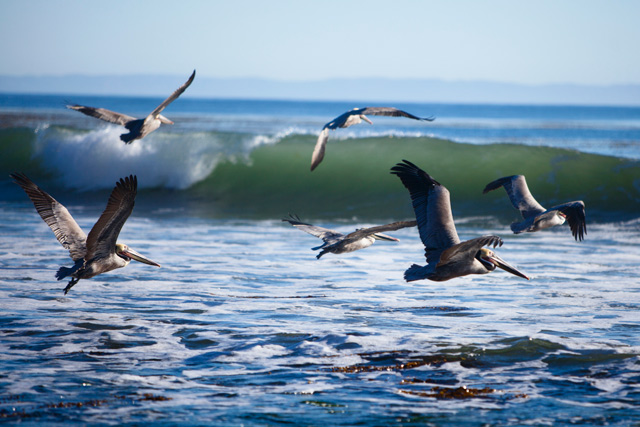Count Pelicans for Science
Take Your Eyes to the Skies for the California Brown Pelican Survey

Scientists are enlisting the help of citizens to count California brown pelicans along the Pacific Coast this Saturday, May 7, between the hours of 5 and 7 p.m. They are hoping that the data collected will allow them to track the health of pelican populations and understand how pelicans are adapting to a changing climate.
About 60 years ago, the iconic California brown pelican almost completely disappeared from the Pacific Coast. The then-widespread insecticide, DDT, was altering the composition of pelican eggshells, making them so thin that the eggs would crack before the chick inside was ready to hatch. After DDT was banned from use in 1972, brown pelican populations recovered, and the bird was officially removed from the Endangered Species List in 2009. But soon after, experts discovered a new problem.
In recent years, far fewer pelicans have been observed coupling on the islands that serve as their breeding grounds. Scientists believe that warmer waters caused by short-term climate changes have driven away sardines, anchovies, and other fish species pelicans feed upon, turning breeding grounds into food deserts. Without a nearby source of food, adult pelicans are unable to nourish both their young and themselves through the breeding season.
There are signs that pelican populations may be adapting to these changes. Brown pelicans have been flocking farther north in unprecedented numbers to Oregon and Washington, and a nesting site has been discovered north of the Channel Islands, which historically marked the uppermost boundary of breeding territory.
These shifts in pelican behavior have scientists concerned about what long-term climate change might mean for the California brown pelican. But to get a clear picture of what’s going on, scientists need eyes on the skies all along the Pacific Coast, from Mexico up to Canada, and researchers don’t have the capacity for such widespread monitoring.
The California Brown Pelican Survey is hoping to change that. A concerted effort between the U.S. Fish and Wildlife Service (USFWS), the Audubon Network, the Cornell Lab of Ornithology’s eBird program, and state agencies, the survey will provide much-needed pelican data by engaging the general public. “This will be the first time, at least along the West Coast, where a coordinated effort of this scale involving citizen science has been undertaken,” says Robert McMorran, a fish and wildlife biologist with the Ventura County office of USFWS.
Anyone can collect and report data, and the process is simple enough. Participants can either register to observe a particular roosting site with an Audubon coordinator, or go to their favorite beach, count adult and non-adult birds between 5 and 7 p.m., and then enter their counts into eBird, an online, crowdsourced bird database. Step-by-step instructions for participating are provided online at ca.audubon.org/conservation/protocol.
Counterintuitively, McMorran hopes that participants on the mainland won’t see many pelicans on Saturday. In spring, which is breeding season, more pelicans on the mainland means fewer pelicans on islands, and fewer pelicans on islands means fewer baby pelicans being born. The opposite will be true for the fall survey in September, when McMorran hopes there will be — now and in the future — pelicans aplenty.



